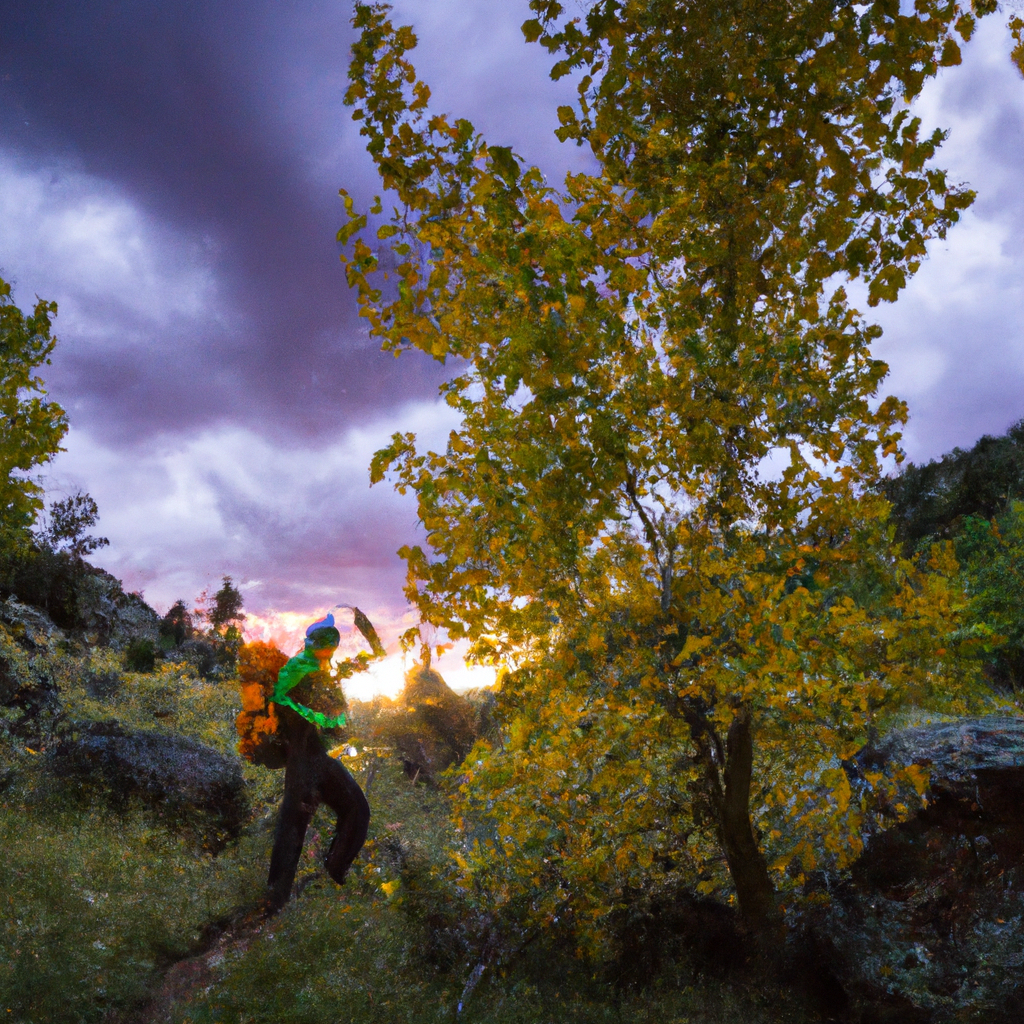Are you ready to step out of your comfort zone and embrace the great outdoors? In this article, we will explore the world of outdoor fitness activities such as hiking, camping, and adventure sports. Whether you’re a seasoned outdoor enthusiast or someone looking to try something new, we’ve got you covered. From the breathtaking views of hiking trails to the thrill of adrenaline-pumping adventures, there’s something for everyone. So put on your hiking boots, grab your camping gear, and get ready for an unforgettable journey into the wild.
Benefits of Embracing the Outdoors
Improving physical fitness
Embracing the outdoors offers numerous benefits for improving physical fitness. Activities like hiking, camping, adventure sports, outdoor workouts, and backpacking all require physical exertion, helping to strengthen muscles, improve cardiovascular health, and increase overall endurance. Engaging in these activities regularly can lead to weight loss, improved flexibility, and increased energy levels. Additionally, outdoor activities often involve uneven terrain, which helps to activate smaller stabilizing muscles and improve balance.
Boosting mental well-being
Beyond the physical benefits, spending time outdoors can significantly boost mental well-being. Research has shown that being in nature can reduce stress levels, anxiety, and depression, while promoting feelings of calmness and well-being. The tranquility and beauty of natural surroundings have a soothing effect on the mind, providing a much-needed break from the hustle and bustle of everyday life. Engaging in outdoor activities also serves as a stress-reliever, allowing you to disconnect from technology and immerse yourself in the present moment.
Connecting with nature
One of the most profound benefits of embracing the outdoors is the opportunity to connect with nature. Whether it’s a serene hike through a forest, camping under a starry sky, or experiencing the thrill of adventure sports, being in nature allows for a deep connection with the natural world. This connection fosters a sense of appreciation and gratitude for the beauty and wonders of the earth. It also offers a chance to learn about different ecosystems, observe wildlife, and develop a greater understanding of the environment.
Building self-confidence
Engaging in outdoor activities can have a transformative effect on self-confidence. Overcoming challenges in the outdoors, such as conquering a difficult hiking trail, learning a new adventure sport, or successfully navigating through unfamiliar terrain, boosts self-esteem and builds resilience. By pushing your physical and mental limits, you gain a sense of accomplishment and develop confidence in your abilities. This newfound confidence can extend to other areas of life, leading to personal growth and a willingness to take on new challenges outside of outdoor activities.
Hiking: The Ultimate Outdoor Experience
Choosing the right hiking trail
When it comes to hiking, choosing the right trail is essential. Consider factors such as difficulty level, distance, elevation gain, and terrain. Beginners may opt for shorter and easier trails with gentle inclines, while more experienced hikers may seek out challenging trails with steep ascents and rugged terrain. It’s also important to research the trail’s condition, weather patterns, and any potential hazards. Online resources and guidebooks can provide valuable information and reviews to help you make an informed decision.
Essential hiking gear
Proper hiking gear is essential for a safe and enjoyable experience. Start with sturdy and comfortable hiking boots that provide ankle support and grip. Dress in layers to accommodate changing weather conditions, and always carry a waterproof jacket and extra clothing. Don’t forget essentials like a backpack, water bottle, trail map, compass, first aid kit, sunscreen, insect repellent, and a whistle for emergencies. In addition, consider trekking poles for added stability and a hat or sunglasses for sun protection.
Preparing for a hiking trip
Before embarking on a hiking trip, it’s important to prepare adequately. Check the weather forecast and plan your hike accordingly, avoiding severe weather conditions. Notify someone of your hiking plans and expected return time for safety purposes. Familiarize yourself with the trail by studying maps and reading up on any potential hazards or landmarks along the way. Pack enough food and water to sustain yourself during the hike, and consider carrying energy-rich snacks for quick boosts of energy.
Safety tips while hiking
While hiking is generally safe, it’s crucial to follow these safety tips to ensure a positive experience. Stay on marked trails to avoid getting lost and respect any closures or restricted areas. Pace yourself and take regular breaks to avoid exhaustion and dehydration. Be mindful of wildlife and give them space, never feeding or approaching them. Carry a means of communication, such as a fully charged cell phone or a whistle, in case of emergencies. Lastly, hike with a partner or inform someone of your hiking plans to ensure someone is aware of your whereabouts.

Camping: Immersing Yourself in Nature
Types of camping
Camping offers a versatile outdoor experience, with various types to suit different preferences. Traditional tent camping involves setting up a tent on designated campsites and sleeping under the stars. RV camping allows for a more comfortable experience with the use of recreational vehicles that provide amenities such as beds, cooking facilities, and bathrooms. For those seeking a unique experience, backcountry camping involves trekking into remote areas and setting up camp away from established campgrounds, providing a truly immersive connection with nature.
Essential camping equipment
To have a successful camping trip, it’s crucial to have the essential camping equipment. A sturdy and reliable tent is essential for providing shelter from the elements. Sleeping bags or air mattresses and blankets ensure a comfortable night’s sleep. Cooking equipment, such as a portable stove or grill, utensils, pots, and pans, allow for enjoyable campsite cooking. Additional items to consider include lanterns or flashlights, a camping chair or hammock, a cooler for food storage, basic tools, and a first aid kit.
Setting up a campsite
Setting up a campsite requires careful consideration of the surroundings and attention to detail. Choose a flat and level area for pitching your tent, ensuring it is away from any potential hazards like falling branches or uneven ground. Clear the area of any debris, rocks, or sharp objects that could damage the tent. Follow the instructions provided with your tent to properly assemble and secure it. Set up a designated area for cooking and eating, and remember to follow any regulations regarding food storage and waste disposal.
Campsite cooking tips
Cooking at a campsite can be an enjoyable and delicious part of the camping experience. Plan your meals in advance and pack ingredients that are easy to store and cook. Consider simple and nutritious options like one-pot meals, foil-wrapped dinners, or grilled vegetables. Opt for lightweight and portable cooking equipment, and bring along spices and condiments to add flavor to your meals. Always follow proper food safety guidelines when handling and storing food to prevent any foodborne illnesses.
Adventure Sports: Thrill and Excitement
Popular adventure sports
Adventure sports offer an adrenaline-rush-filled outdoor experience for thrill-seekers. Some popular adventure sports include rock climbing, whitewater rafting, ziplining, bungee jumping, skydiving, mountain biking, and paragliding. Each sport offers its own unique set of challenges and excitement, allowing participants to push their limits and experience an unparalleled sense of accomplishment.
Choosing the right adventure sport
When choosing an adventure sport, consider your personal preferences, fitness level, and comfort with heights or water. Research the requirements, safety measures, and potential risks associated with each sport to make an informed decision. If you’re a beginner, it may be wise to start with an introductory course or guided experience to learn the basics and build confidence. Always prioritize safety by choosing reputable operators, checking equipment, and following the guidance of experienced instructors.
Training and preparation
Preparing for an adventure sport involves physical conditioning and specific skill-building. Engage in regular cardiovascular exercises to improve endurance, strength training to build core and upper body strength, and flexibility exercises to enhance mobility. Additionally, practice sport-specific skills such as climbing techniques, paddling strokes, or proper landing techniques. It’s also important to mentally prepare by visualizing successful outcomes and managing fear or anxiety associated with the sport.
Safety precautions
Adventure sports can be thrilling, but safety should always be a top priority. Participate in adventure sports with trained professionals and reputable organizations that prioritize safety protocols. Follow all instructions and guidelines provided by instructors, and never attempt to engage in any adventure sport without proper training and supervision. Use appropriate safety equipment, including helmets, harnesses, life jackets, and protective gear. It’s important to be aware of your physical and mental limits and communicate any concerns or discomfort to the instructors.

Outdoor Workouts: Fitness in the Wild
Benefits of outdoor workouts
Taking your workout routine outdoors provides several benefits beyond those of indoor exercise. Outdoor workouts expose you to fresh air and vitamin D from sunlight, which can boost mood and energy levels. The changing terrain challenges your muscles in different ways, resulting in improved balance, stability, and agility. Outdoor workouts also offer a sense of freedom and connection with nature, making them more enjoyable and motivating.
Outdoor workout ideas
There are countless outdoor workout options to choose from, depending on your preferences and fitness goals. Running or jogging in a park or on a trail offers a cardiovascular workout while enjoying the natural surroundings. Bodyweight exercises like push-ups, squats, and lunges can be performed in a local park or backyard, using benches or playground equipment. Yoga or Pilates classes in outdoor settings provide a relaxing and rejuvenating workout experience. Cycling, swimming, or hiking are also great options for outdoor workouts.
Safety considerations
While outdoor workouts can be invigorating, it’s important to prioritize safety. Start with a proper warm-up to prepare your muscles and joints for exercise. Stay hydrated by carrying water with you, especially on hot days. Dress appropriately for the weather, wearing breathable and moisture-wicking clothing. Use sunscreen to protect your skin from the sun’s harmful rays, and wear a hat and sunglasses for additional protection. Be mindful of your surroundings, watch for uneven surfaces or obstacles that may cause tripping or falling, and exercise caution when venturing into remote areas.
Exploring National Parks: Natural Wonders
Why visit national parks
National parks offer unparalleled natural beauty, diverse ecosystems, and endless opportunities for exploration and adventure. They provide a chance to disconnect from the fast-paced world and immerse yourself in the wonders of the natural environment. National parks also play a crucial role in preserving biodiversity, protecting endangered species, and educating visitors about conservation and sustainability. Whether you’re seeking solitude, adventure, or a deeper connection with nature, national parks offer something for everyone.
Selection of notable national parks
The United States is home to several notable national parks, each with its own distinctive features and attractions. Yellowstone National Park, the first national park in the world, boasts geothermal marvels like the iconic Old Faithful geyser. Yosemite National Park captivates visitors with its towering granite cliffs, impressive waterfalls, and ancient sequoia groves. Grand Canyon National Park is renowned for its awe-inspiring vistas and breathtaking canyon depths. Other notable national parks include Zion National Park, Rocky Mountain National Park, Glacier National Park, and Acadia National Park.
Activities and attractions in national parks
National parks offer a wide range of activities and attractions for visitors to enjoy. Hiking trails of varying difficulty levels provide opportunities to explore the parks’ stunning landscapes and wildlife habitats. Scenic drives allow for breathtaking views and photo opportunities. Many national parks offer opportunities for camping, allowing visitors to spend the night under the stars. Wildlife watching, birdwatching, fishing, and boating are popular activities in national parks with diverse ecosystems. Education and interpretive programs provide insights into the park’s history, geology, and conservation efforts.

Backpacking: Traveling Light, Traveling Far
Essential backpacking gear
Backpacking involves carrying all your essential gear and supplies on your back, enabling you to explore remote and off-the-beaten-path destinations. Essential backpacking gear includes a lightweight and durable backpack that fits comfortably, with adjustable straps and proper weight distribution. A sturdy and compact tent, sleeping bag, and sleeping pad are necessary for a good night’s sleep. A water filtration system or purification tablets ensure a safe and clean water supply. Lightweight cooking equipment, nutritional food, navigation tools, and appropriate clothing are also crucial.
Preparing for a backpacking trip
Preparing for a backpacking trip involves careful planning and consideration of your needs and destination. Research your chosen trail or destination, including trail conditions, expected weather patterns, and any necessary permits or reservations. Create a detailed packing list to ensure you have all the essential gear and supplies. Test your equipment beforehand to ensure it functions properly and fits comfortably. Physical conditioning, including cardiovascular and strength training exercises, is important to build endurance for long hikes while carrying a backpack.
Navigating and orienteering
Navigating and orienteering skills are essential for backpackers, as many trails and destinations may not have clearly marked paths. Learn how to read maps, use a compass, and understand landmarks and topographic features. Familiarize yourself with basic navigation techniques, such as using cardinal directions and triangulation. Practice orienteering skills in a controlled environment before venturing into the wilderness. Additionally, consider carrying a GPS device or smartphone with offline navigation apps as backup tools.
Safety tips for backpacking
Safety should always be a priority when backpacking. Inform someone of your itinerary and expected return time, and check in with them upon your return. Be aware of potential hazards on the trail, such as wildlife encounters, inclement weather, or challenging terrains. Carry a first aid kit and know how to use it for minor injuries. Stay hydrated and nourished throughout the trip, and be mindful of proper food storage to prevent attracting wildlife. Respect any Leave No Trace principles to preserve the natural environment and minimize your impact on the trail.
Survival Skills: Thriving in the Wilderness
Basic survival skills
Having basic survival skills is crucial for anyone venturing into the wilderness. These skills include knowing how to start a fire, build a shelter, find and purify water, and navigate without the use of technology. Familiarize yourself with different fire-starting techniques, such as using flint and steel or friction methods. Learn how to construct a shelter using natural materials, providing protection from the elements. Understand various methods of sourcing and purifying water to ensure a safe and drinkable supply. Finally, practice navigation skills using a compass and natural landmarks.
Shelter and fire building
In survival situations, building a shelter and starting a fire are vital for ensuring warmth, protection, and visibility. Look for a suitable location for your shelter, taking into account factors like wind direction, terrain, and proximity to water sources. Use natural materials such as branches, leaves, and rocks to build a shelter that offers insulation and protection from the elements. When starting a fire, gather dry tinder, kindling, and fuelwood. Utilize fire-starting techniques like sparks from a ferrocerium rod, friction methods, or using a fire starter kit.
Finding water and food in the wild
Finding water and food sources in the wild is crucial for survival. Look for potential water sources such as rivers, streams, or lakes. Be cautious of stagnant water, as it may be contaminated. If necessary, purify water by boiling it or using water filtration or purification methods. In terms of food, familiarize yourself with edible plants and wild fruits in your area. Learn basic fishing and trapping techniques to catch fish or small game. Always exercise caution and avoid eating any plants or animals unless you are confident in your identification skills.
Navigation and signaling
Being able to navigate and signal for help in the wilderness is essential in emergency situations. Learn how to use a compass and read topographic maps to determine your position and desired direction. Identify prominent landmarks or natural features that may help you find your way. In case of an emergency, create visible signals using bright clothing items, mirrors, or reflective surfaces to attract attention. Carry a whistle or other signaling devices to alert potential rescuers of your presence. Practice basic signaling techniques, such as using Morse code for communication.

Outdoor Photography: Capturing Nature’s Beauty
Choosing the right camera equipment
Capturing stunning outdoor shots requires the right camera equipment. Invest in a high-quality camera with manual controls and interchangeable lenses to have maximum control over your photographs. Wide-angle lenses are ideal for capturing landscapes, while telephoto lenses allow for detailed shots of wildlife or distant subjects. Consider carrying a tripod to ensure stability and sharpness in your images, especially during low-light conditions. Additionally, protect your gear by investing in a durable camera bag and bringing along lens cleaning tools and spare batteries.
Composition and techniques
Composition plays a significant role in creating captivating outdoor photographs. Keep the rule of thirds in mind, placing your main subject off-center to create a more visually appealing image. Utilize leading lines, such as paths or rivers, to guide the viewer’s eye through the photograph. Experiment with different angles and perspectives to add depth and interest to your shots. Take advantage of natural lighting conditions, such as the golden hours of sunrise and sunset, to create soft and warm tones. Finally, always be patient and observant, waiting for the perfect moment to capture the essence of the scene.
Tips for capturing stunning outdoor shots
To capture stunning outdoor shots, consider these additional tips. Research the location and visit during the best seasons for optimal lighting and weather conditions. Experiment with different camera settings, such as aperture and shutter speed, to achieve the desired effect. Take multiple shots from different angles and focal distances to ensure you capture the scene in its entirety. Pay attention to the details, focusing on intricate patterns, textures, or colors in the natural environment. Finally, remember to immerse yourself in the moment and enjoy the beauty of nature while capturing its essence through photography.
Environmental Considerations: Respecting Nature
Leave No Trace principles
Respecting and preserving nature is essential to ensure its longevity and the enjoyment of future generations. Embrace the Leave No Trace principles, which advocate for minimum impact practices in the outdoors. These principles include properly disposing of waste, packing out what you pack in, and leaving natural and cultural features as you found them. Respect wildlife by observing from a distance and never feeding or disturbing them. Stay on designated trails to prevent erosion and damage to fragile ecosystems. Educate yourself and others about responsible outdoor ethics to promote sustainability and conservation.
Protecting wildlife habitats
Preserving wildlife habitats is crucial for maintaining biodiversity and the delicate balance of ecosystems. Observe wildlife from a safe distance, using binoculars or zoom lenses to avoid causing stress or disturbance. Never attempt to feed or touch wild animals, as it can disrupt their natural behaviors and potentially lead to human-wildlife conflicts. Avoid sensitive areas, such as nesting sites or breeding grounds, during critical times of the year. Respect any regulations or guidelines provided by park authorities to ensure the well-being and protection of the wildlife and their habitats.
Minimizing environmental impact
Minimizing your environmental impact is essential to preserve the natural beauty of outdoor spaces. Avoid using single-use plastics and disposable items, opting for reusable alternatives instead. Properly dispose of waste and litter in designated receptacles or carry it out with you if none are available. Use environmentally friendly cleaning and personal care products to prevent contamination of water sources. Keep noise levels down to minimize disturbance to wildlife and other visitors. Educate yourself on local environmental issues and consider volunteering with conservation organizations to contribute to the preservation and restoration of natural areas.
In conclusion, embracing the outdoors offers numerous benefits, ranging from improving physical fitness and boosting mental well-being to connecting with nature and building self-confidence. Activities like hiking, camping, adventure sports, outdoor workouts, exploring national parks, backpacking, learning survival skills, outdoor photography, and considering environmental considerations all provide unique opportunities to immerse yourself in the natural world. By enjoying these outdoor experiences, you can cultivate a deeper appreciation for nature, enhance your physical and mental well-being, and create unforgettable memories in the wild. So, step outside and embrace all that the outdoors has to offer!






